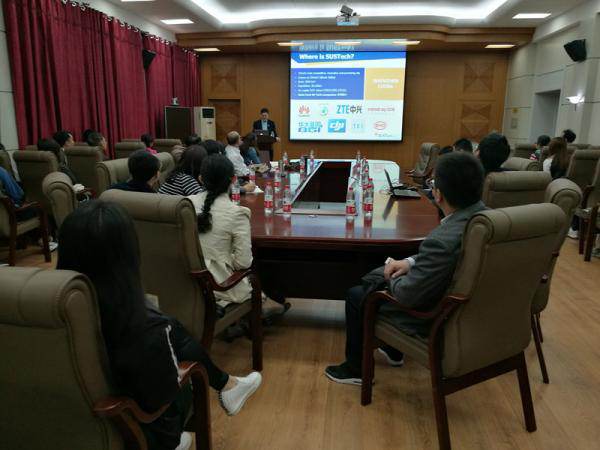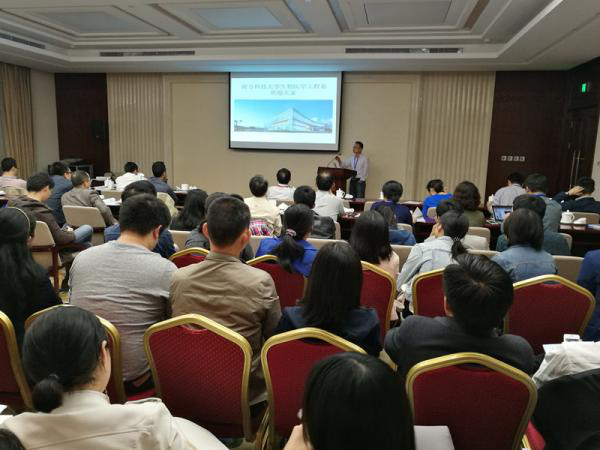For two days in late April 2017, 23 and 24 to be exact, a delegation from our University, led by our founding Dean Prof X. Edward Guo called successively on three universities, i.e.Hebei University of Technology, Nankai University, Tianjin University. The team, in addition to the Dean, was composed of Executive Dean Prof Chen Fangyi, Prof Wu Changfeng, and Associate Professor Tang Bin. They were there to get acquainted with the latest developments in teaching, research and talent-building in these three peer institutions. They were also there to talk collaboration.

The Dean in full flow
Prof Guo kicked off the visit on the morning of the 23rd by giving a lecture on “Building a Research Career: My Personal Experience” at the Biophysics Institute at Hebei University of Technology. Presiding over the proceedings was Prof Zhan Yong, Director of the Institute. Interestingly, Prof Guo began his speech by quoting Confucius as it related to his life and development, followed by valuable insights from his research in the United States in the prime of his life. Prof Guo had the audience lapping up his words of wisdom. He must have been pleased by the passionate discussions that ensued. After the lecture, the visiting scholars were given a guided tour of the laboratory.

Waiting to get into the lab
Later, in the afternoon, our delegation headed for the Institute of Life Science at Nankai University. They were graciously hosted by Prof Kong Deling, Director of the Key laborary of bioactive materials of the Ministry of Education, as well as Prof Wang Shufang. The Director introduced the personnel of the key lab and their scientific research. After mutual briefing, the two sides reached an understanding or intent to begin exchange visits and research cooperation. Finally, they were given a VIP tour of the key lab.

The fruits of friendship
The second day of the itinerary was taken up by a visit to the Institute of Precision Instruments at Tianjin University where they were warmly received by the Director of Tianjin Key Laboratories of Biomedical Detection Technology and Instruments. They were delighted to be given an insider’s look at the lab.

All eyes on you

About the Three Universities:
The discipline of Biological Physics at Hebei University of Technology was established in 1999. A year later, it was granted the right to confer Master’s degrees in Theoretical Physics, and with that it began to recruit graduate students to its biophysics program. By 2002, it was further granted the right to confer Doctoral degrees in electrical engineering. With this right, they began to recruit doctoral students in biophysics. The following year, it was formally authorized to confer Master’s degrees in biophysics, and within that same year, it established the biophysics research institute. By 2012, this discipline was classified as a key academic discipline in Hebei province. A year later, the physics lab of molecular biology under the multi-discipline of Biological Physics was designated the key lab in Hebei province.
Nankai University’s Key Laboratory of Research on Bioactive Materials under the authority of the Ministry of Education was established in 1994. By virtue of its relationship with Nankai University, it was authorized to be open to the outside world by the Ministry of Education in 1996. Three years later, its name was changed to Key Laboratory of Bioactive Materials under the Ministry of Education, and as such, it passed the assessment by the same ministry another three years later. Its research domain encompasses biomedical engineering, which is a cross discipline between chemistry, biology and medicine. This being so, it enjoys the right to confer Master’s degrees and Doctoral degrees in polymer chemistry and physics, biochemistry and molecular biology.
Tianjin University’s School of Precision Instrument and Opto-electronic Engineering, or School of Precision Instrument for short, was established on 2 October, 1995. It was built on the foundation of the original Precision Instrument Engineering Faculty that came into being in 1959, whose predecessor was the Precision Instrument Engineering Discipline that dated back to 1952. In 2008, it was reconstituted as “the Integrated Reform Experimental District”. By 2011 it was designated a “National Experimental School”.






